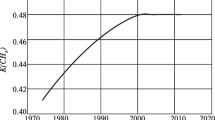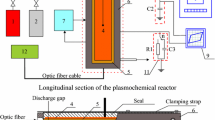We propose a novel technology for separation of methane from oxygen-containing coal bed gas via hydrate formation from solutions of promoters: tetrahydrofuran and sodium dodecyl sulfate. Experiments on methane separation from a model gas were conducted at different initial pressures. As shown by the results, hydrate formation in the presence of tetrahydrofuran and concentration of the methane are possible at a temperature of 5°C and a pressure of 0.3 MPa. The methane concentration can be raised from 16.45% to 61.7%. If the pressure is reduced from 1 MPa down to 0.3 MPa with no change in temperature, the selectivity of methane separation increases.





Similar content being viewed by others
References
C. Y. Sun, C. F. Ma, G. J. Chen, and S. X. Zhang, “Experimental and simulation of single equilibrium stage separation of (methane + hydrogen) mixtures via forming hydrate,” Fluid Phase Equilibria, 261, 85–91 (2007).
J. Happel, M. A. Hnatow, and H. Meyer, “The study of separation of nitrogen from methane by hydrate formation using a novel apparatus,” Annals of the New York Academy of Sciences, 715, 412–424 (1994).
A. H. Mohammadi, A. Eslamimanesh, V. Belandria, and D. Richon, “Phase equilibria of semiclathrate hydrates of CO2, N2, CH4, or H2 + tetra-n-butylammonium bromide aqueous solution,” J. Chem. Eng. Data, 56, 3855–3865 (2011).
“Study suggestion on coal bed gas and coking gas resource scientific recovery and safe utilization,” Journal of Chinese Academy of Sciences, 22, 476–477 (2007). [in Chinese]
K. W. Liu, M. Gu, and X. F. Xia, “Research progress in concentration of methane from CH4/ N2 by PSA,” Modern Chemical Industry, 27, 15–18 (2007). [in Chinese]
Q. L. Ma, G. J. Chen, C. F. Ma, and L. W. Zhang, “Study of vapor–hydrate two-phase equilibria,” Fluid Phase Equilibria, 265, 84–93 (2008).
Hideo Tajima, Akihiro Yamasaki, and Fumio Kiyono, “Energy consumption estimation for greenhouse gas separation processes by clathrate hydrate formation,” Energy, 29, 1713–1729 (2004).
H. Q. Yang, Z. H. Xu, M. H. Fan et al., “Progress in carbon dioxide separation and capture: A review,” Journal of Environmental Sciences, 20, 14–27 (2008).
E. D. Sloan, Clathrate Hydrates of Natural Gases, Marcel Dekker, New York (1998).
G. J. Chen and T. M. Guo, “A new approach to gas hydrate modeling,” Chemical Engineering Journal, 71, 145–151 (1998).
K. H. Xue, J. F. Zhao, Y. C. Song, W. G. Liu, W. H. Lam, Y. M. Zhu, Y. Liu, C. X. Cheng, and D. Liu, “Direct observation of THF hydrate formation in porous microstructure using magnetic resonance imaging,” Energies, No. 5, 898–910 (2012).
D. L. Zhong and Peter Englezos, “Methane separation from coal mine methane gas by tetra-n-butyl ammonium bromide semiclathrate hydrate formation,” Energy Fuels, 26, 2098–2106 (2012).
Author information
Authors and Affiliations
Corresponding author
Additional information
Translated from Khimiya i Tekhnologiya Topliv i Masel, No. 3, pp. 40 – 43, May – June, 2013.
Rights and permissions
About this article
Cite this article
Zhao, J., Tian, Y. & Zhao, Y. Separation of Methane from Coal Bed Gas via Hydrate Formation in the Presence of Tetrahydrofuran and Sodium Dodecyl Sulfate. Chem Technol Fuels Oils 49, 251–258 (2013). https://doi.org/10.1007/s10553-013-0438-4
Published:
Issue Date:
DOI: https://doi.org/10.1007/s10553-013-0438-4




